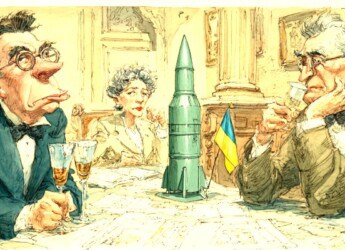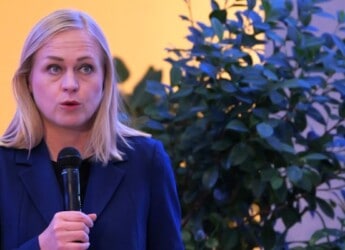Editor’s Note: This concise article covers the latest developments in the ongoing Russia-Ukraine war, focusing on the recent Ukrainian drone strikes targeting multiple Russian airbases and the broader implications of these attacks. The piece also explores the evolving tactics employed by both sides, the reported use of chemical weapons by Russian forces, and the Kremlin’s efforts to indoctrinate Ukrainian youth in occupied territories.
Notably, the article highlights the ongoing Russian cyber attacks against European critical infrastructure, as revealed by Czech Transport Minister Martin Kupka and the European Union Agency for Cyber Security (ENISA). This information is particularly relevant for cybersecurity, information governance, and eDiscovery professionals, as it provides valuable insights into the tactics and strategies employed by pro-Russian hacker groups. Understanding these threats is crucial for protecting critical infrastructure, ensuring the integrity of information systems, and facilitating investigations and litigation related to potential human rights abuses and violations of international law.
Source Note: One of the most accurate and detailed sources for ongoing updates on the Ukraine crisis is the Russian Offensive Campaign Assessment from the Institute for the Study of War. The Institute for the Study of War (ISW) is a 501(c)(3) organization and produces strictly non-partisan, non-ideological, fact-based research. ISW seeks to promote an informed understanding of war and military affairs through comprehensive, independent, and accessible open-source research and analysis. ISW’s research is made available to the general public, military practitioners, policymakers, and media members. Providing a daily synthesis of key events related to the Russian aggression against Ukraine, ISW updates may benefit investigators and litigators as they follow the business, information technology, and legal trends and trajectories impacted by and stemming from the current Russo-Ukrainian conflict.
For those seeking to grasp the full scope of this evolving landscape, the complete updates from the Institute for the Study of War serve as an invaluable resource.
Content Assessment: Drone Warfare and Cyber Attacks: The New Frontlines of the Ukraine Conflict (April 5, 2024)
Information - 94%
Insight - 93%
Relevance - 94%
Objectivity - 93%
Authority - 95%
94%
Excellent
A short percentage-based assessment of the qualitative benefit expressed as a percentage of positive reception of the recent update on the Russo-Ukrainian conflict as written by ComplexDiscovery OÜ from Institute for the Study of War reporting.
Russo-Ukrainian Conflict Update*
Drone Warfare and Cyber Attacks: The New Frontlines of the Ukraine Conflict (April 5, 2024)
ComplexDiscovery Staff
In a significant escalation of the conflict, Ukraine’s Security Service (SBU) and Ukrainian forces reportedly conducted one of the largest coordinated attacks deep inside Russia since the start of the war. According to Ukrainian media reports citing security sources, the strikes targeted at least four Russian airbases on the night of April 4 to 5.
The drone strikes, which occurred at airfields near Kursk City, Yeysk in Krasnodar Krai, the Engels Airbase in Saratov Oblast, and the Morozovsk Airbase in Rostov Oblast, are said to have inflicted substantial damage on Russian military assets. Ukrainian security sources claim that the attacks significantly damaged three Tu-95MS strategic bombers at Engels Airbase, two Su-25 fixed-wing aircraft at the airbase near Yeysk, and destroyed six unidentified aircraft while significantly damaging another eight at the Morozovsk Airbase.
The strikes also reportedly resulted in casualties among Russian military personnel, with four killed at the airbase near Yeysk, seven at the Engels Airbase, and up to 20 wounded and killed at the Morozovsk Airbase. Geolocated footage confirms explosions and the activation of Russian air defenses near all the targeted airbases except for the one near Yeysk.
This development underscores Ukraine’s growing capability to strike deep within Russian territory and disrupt Russia’s air force operations. The Tu-95 strategic bombers stationed at Engels Airbase have been routinely used to launch cruise missiles at targets in Ukraine, and the potential loss of roughly five percent of Russia’s strategic Tu-95 bombers in a single strike could have significant implications for Russia’s ability to conduct long-range attacks.
Despite the success of the Ukrainian strikes, Russia continues to intensify its offensive operations in Ukraine, which is expected to result in increased manpower and material losses. However, the Russian Ministry of Defense appears to be successfully mitigating these losses through ongoing crypto-mobilization efforts, recruiting around 30,000 personnel per month to replenish losses and form tactical and operational-level reserves.
Moreover, the Russian military has shifted its tactics, employing more armored vehicles in recent assaults, suggesting that it may no longer be as constrained by vehicle losses as previously thought. Experts assess that Russia’s defense industry can produce, modernize, or repair hundreds of tanks annually, enabling the country to sustain its current rate of vehicle losses for at least two to three years by drawing from its Soviet-era storage.
As the conflict persists, Ukrainian Prime Minister Denys Shmyhal emphasized the need for continued Western military assistance to equip newly formed Ukrainian units. Shmyhal also reported that recent Russian missile and drone strikes have damaged or disrupted roughly 80 percent of electricity generation at Ukrainian thermal power plants as Russian forces exploit the degraded Ukrainian air defense umbrella to collapse Ukraine’s energy grid.
Ukrainian officials have also raised concerns about the systematic and increasing use of chemical weapons and other likely-banned chemical substances by Russian forces in Ukraine. The Ukrainian Support Forces Command reported 1,412 cases of Russian forces using chemical weapons between February 2023 and March 2024, primarily using K-51 and RG-VO grenade launchers to deploy munitions containing chemical agents.
In addition to the military conflict, Russia has been waging a cyber war against European states’ critical infrastructure. Czech Transport Minister Martin Kupka revealed that Russia has conducted thousands of cyber-attacks against Czechia’s rail transport infrastructure and that of other European states to degrade NATO members’ transport logistics. The European Union Agency for Cyber Security (ENISA) in 2023 reported that pro-Russian hacker groups had escalated major cyberattacks against railway companies in Latvia, Lithuania, Romania, and Estonia, as well as air and maritime transport in the EU more broadly.
As the war enters its third year, Russian President Vladimir Putin announced plans to open two youth centers aimed at indoctrinating Ukrainian youth into Russian culture and historical narratives in occupied Zaporizhia and Kherson Oblasts, highlighting the Kremlin’s long-term strategy to exert influence over the occupied territories.
The ongoing conflict in Ukraine remains a complex and dynamic, with both sides adapting their strategies and tactics to gain an advantage. As Ukraine continues to demonstrate its ability to strike deep within Russian territory and disrupt Russian military operations, the international community closely monitors the situation, with the potential for further escalation and the need for continued diplomatic efforts to bring an end to the conflict.
News Sources
- Institute for the Study of War (understandingwar.org)
- Russian Orthodox Church Declares Ukraine Invasion a ‘Holy War’ Amid Kremlin’s Tightening Grip (March 29, 2024) (complexdiscovery.com)
As a leading source for cybersecurity, information governance, and legal discovery insights, including international investigations and litigation, ComplexDiscovery OÜ recognizes the importance of awareness regarding alleged and documented criminal acts, particularly in the context of the Russia-Ukraine conflict. While we, following the lead of the Institute for the Study of War (ISW), do not provide detailed coverage of war crimes in our primary reports, we encourage professionals within the eDiscovery ecosystem to stay informed about these activities. This awareness is crucial for understanding potential future legal actions and responsibilities.
Detailed Reporting with Maps for April 5, 2024, from the ISW – Mouseover to Scroll
Russo Ukraine Conflict Update - April 5 2024Review the Detailed Reporting and Maps PDF
About the Institute for the Study of War Research Methodology
ISW’s research methodology relies on both primary and secondary sources, enabling researchers to develop a comprehensive understanding of the situation on the ground. In order to analyze military and political developments in any given area, ISW’s research analysts must wholly understand the systems of enemy and friendly forces. They must also understand the population demographics, physical terrain, politics, and history of that area. This lays the analytical foundation for understanding the reasons for particular developments and fulfilling their assigned research objectives. ISW analysts also spend time in places like Iraq, Afghanistan, and elsewhere in order to gain a better understanding of the security and political situation and to evaluate the implementation of current strategies and policies. Our researchers compile data and analyze trends, producing a granular analysis of developments in areas of research, producing an accurate, high-resolution, timely, and thorough picture of the situation. ISW’s research methodology guarantees its success and commitment to improving the nation’s ability to execute military operations, achieve strategic objectives, and respond to emerging problems that may require the use of American military power.
About the Institute for the Study of War
The Institute for the Study of War advances an informed understanding of military affairs through reliable research, trusted analysis, and innovative education. We are committed to improving the nation’s ability to execute military operations and respond to emerging threats in order to achieve U.S. strategic objectives. ISW is a non-partisan, non-profit, public policy research organization.
Learn more, get involved, and contribute today.
Additional Reading
- From Dissent to OSINT? Understanding, Influencing, and Protecting Roles, Reputation, and Revenue
- [Annual Update] International Cyber Law in Practice: Interactive Toolkit
- Data Embassies: Sovereignty, Security, and Continuity for Nation-States
Assisted by GAI and LLM Technologies
* Sourced and shared with direct express permission from the Institute for the Study of War (ISW).
Source: ComplexDiscovery OÜ



























